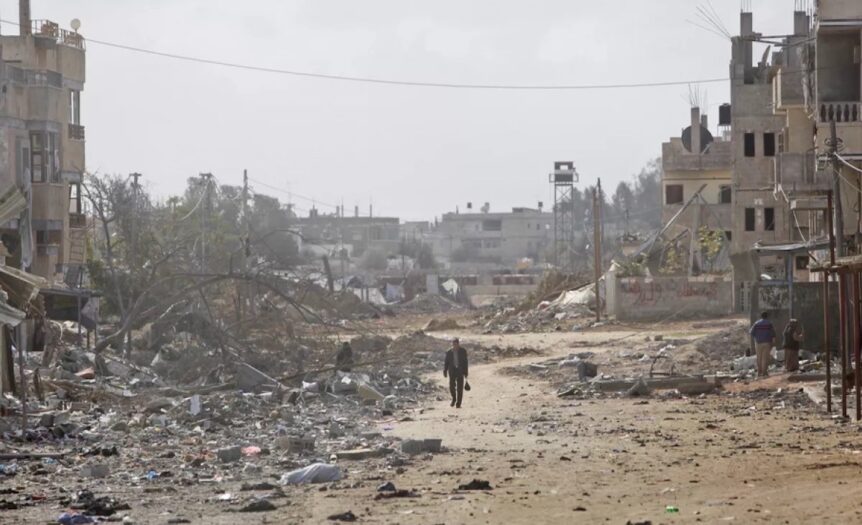Comment by Yara Sharif, architect of Architects For Gaza e Palestine Regeneration Project
GAZA (PALESTINE). The recent cease-fire deal opens a new phase for Gaza-Strip. The 2 million of inhabitants area – very dense, strongly destroyed by last months’ Israelian attacks, with almost 50 thousands of killed people by the strikes according to International data – needs understanding, support and cooperation. As well as new urban and architectural visions for rebuilding its own future.
Destruction, not only physical
According to some surveys, 70% of the buildings are currently destroyed. For others are around 80%. But this is not the point, the extent of the destruction is not related just to physical buildings. There are many intangible aspects to be stressed: one of the most impacting concerns the rubble. You could tell: “Let’s move the rubble and let’s start with the reconstruction”. But in those rubbles you find human bodies, they’re urban and social memories. In Gaza we’re facing an urban disaster and an environmental disaster. But bombs and strikes are not the only enemies. Thousands of misplaced people are living in refugees’ camps, such as Jabalia. They’re mostly built with asbestos; people are sniffing and are poisoned.
It’s another type of death, slow and fatal.
Rediscussing the notion of home
With the truce, the population is getting back home. Or, better, to the place where homes were. Where now mostly ruins are. It’s my personal experience: I’ve lost my family in the first weeks of attacks.
In Gaza we need to reconsider the concept itself of home. Definitions as urbicide or ecocide are relevant, but the reality sounds more complex. The trickiest, and uncomfortable questions, are about what can be home, what are the borders of each home, how we can live. There is also a mental dimension. In the cities of Gaza-Strips the public space, and mainly the streets, were intended as prosecution of private homes. They were the living rooms. And in the coastal area the synergies with the open spaces were part of our life. All of that is gone in the war. The neighborhood is not more a factor of the social tissues as it was. The relationships among the urban and architectural elements were destroyed.
We need to restart from here: what can be home today in Gaza?
Designing the future, is it possible now?
It’s a very challenging question. We’re visiting Gaza and Palestine, daily we have contact with our partners there. Now we’re in the phase of considering emergency reconstruction, starting from public buildings, facilities and infrastructures.
Gaza now is a city of shelters, relationships with the streets, with the sea, with the landscape are gone. How is it possible to think about topics of sustainability or resiliency in such a situation? There are ruins to be moved, we need to choose the correct materials for the emergency shelters, there is no sufficient land to be occupied by new architectural and urban elements. We need to start from scratches.
But we need also to be aware of who is committed in this first reconstruction stage. In previous wars many international companies were involved. I don’t like this phenomenon. Gaza doesn’t need just new buildings or streets to replace the ones destroyed. Gaza is its coastal edges, is the diverse agricultural traditions.
We want to reconstruct the environments and it will be a long and difficult path.
Gaza Global University
We decided to establish Architects for Gaza out of the emergency and of the urgency. We thought architects must speak out, telling the world what was happening here. We have gathered many colleagues, academics, professionals, planners. Everybody gave the voice screaming that a genocide was running. It was and it’s a question of responsibility: facing Gaza destruction you cannot be quiet and complicit.
Architects must stand up and call for action. We tried to help in the emergency by establishing a virtual University, the Gaza Global University, with 800 hundred volunteers trying to support and empower local universities.
Rebuilding the hope for the future
Our idea was to work here, in Palestine, in Gaza, without pushing students and researchers to go outside. We got a lot of support from West Bank Universities, such as An-Najah National University in Nablus.
The situation is very difficult. Students are eager and committed to education, they’re moving back to the cities. But the university infrastructures are destroyed. Working with students is a very impacting and challenging path. They’ve experienced tragic moments, there is a mental emotional aspect we need to work with: they feel unsettled, they had to flee, there are very pragmatic absences, such as electricity.
We cannot deliver education in the traditional way. We have worked with platforms, with workshops (for instance in Cairo). With one-to-one relationships.
Now students want to go back home. With education paths we need to rebuild also the hope for Gaza.
Cover Image: Gaza 2023 (© Ben Curtis/AP)
More info: Architects for Gaza – Palestine Regeneration Project
About Author
Tag
gaza , reconstruction , war
Last modified: 29 Gennaio 2025
























